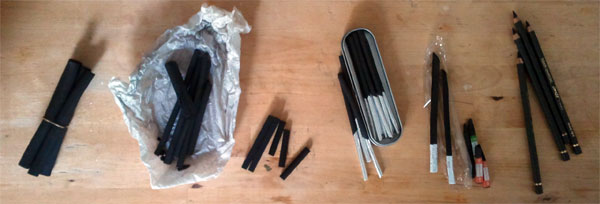When I first wanted to start painting I wondered which colours to buy. I did some research and discovered many different palette systems. That is particular sets of colours that work together. Each system seemed to come with a particular way of thinking; an approach required to make best use of that particular set of colours.
If you’re as bewildered as I was, read on: below is a summary of the main systems that I found. If your palette is more established you might be interested to see which systems your palette relates to most closely, or perhaps find some ideas on how to develop it further.
Palette Systems:
Grisaille Palette:
This is about as simple as it gets without being monochrome. The grisaille palette typically consists of black, white and raw umber. The term grisaille is french for grey tones. (The Italian term, ‘Verdaccio’ is closely related but seems to be used more often with reference to underpainting or ‘dead colour’ layers in multi-layer techniques. I’ll clarify this when I find something or someone authoritative!)
I was introduced to this palette at LARA (The London Atelier of Representational Art) for cast painting. They use ivory black as their black as it is a very blue black (mix some with white and you’ll see what I mean). Grisaille is primarily used for tonal work but is also allows the study of warm and cool variations in relation to lighting conditions, which is great prelude to using more colour.
‘Limited’ Palette:
More of a term than a specific palette, it refers to any palette with a small range of colours.
The Zorn Palette:
The Zorn palette is a very limited palette and was one of several used by Anders Zorn. It is the basis of many other, slightly less limited palettes. It was based on the earth pigment versions of the primary colours and is typically cited as:
Red: Vermillion (though Cadmium red light is usually substituted here)
Yellow: Yellow ochre
Blue: Ivory black (acting as a blue here)
Double (Warm and Cool) Primaries:
I have often seen this palette recommended as a good general purpose palette, as the name suggests it has warm and cool versions of each of the primary colours. A typical version is:
Warm red: Cadmium red
Cool red: Alizarin crimson
Warm yellow: Cadmium yellow medium
Cool yellow: Lemon yellow/cadmium yellow light
Warm blue: Ultramarine blue
Cool blue: Prussian of Thalo blue
plus black and white.
Any paint or pigment quality can be the basis for its selection or inclusion in a particular palette, not just hue but value, transparancy and consistency can all be considered.
Historical Authority
Many artists and schools cite historical precedent as an influence in their choice of palette. The desire to draw on the qualities of particular schools or master artists has led many to adopt the palettes of their masters, both traditional and contemporary.
It is very useful to understand how the choice of techniques was limited by the available pigments, for much of art history, whereas now our choice of technique influences our choice of pigment. Further information about the historical availablility of different pigments is available on Tony Johansen’s paint-making.com website.
Which to choose?
It is not essential to pick any of them but it will give you a good starting point to select a predefined palette, rather than an arbitrary collection of colours. I found that I could see what others had accomplished with a specific palette and sometimes get some insight into how they did it.
Each palette system thas particular strengths and weaknesses so a palette that is good for painting the figure is unlikely to be good for landscape without adding or removing certain pigments.
I’ve found it very helpful to get to know my starting palette well before adding many more colours. Otherwise it can be very difficult to mix the colour you are aiming for and if you do manage, you may not be able to repeat that mix. To begin with I spent a little time making colour charts; it sounds boring but it really helped me to find my way around my palette.
My initial strategy was to buy as few colours as possible and just add to them as necessary. So far that strategy has worked well; I haven’t done much painting but I am starting to appreciate some of the finer points of mixing the few colours that are on my palette.
Simultaneous Contrast
Colour charts do not help at all with translating colours from palette to painting though, since all the surrounding colours the make the mixes look entirely different on the canvas. This phenomena is called the principle of simultaneous contrast and is a key part of colour theory.
Gurney Gamut
With a specific palette of pigments there are a limited number of possible colours that can be mixed. James Gurney’s video offers the best explanation and demonstration of this idea.
Thinking in pigments
The tools you are using largely determine how you think about and approach your painting. If you limit your palette to grissaille for example you are obliged to approach your painting in terms of value or warm-cool relationships, conversely as you add colours to your palette it seems to suddenly open up those possible choices in how you think about your painting.
Whichever starting point you choose it is as well to experiment with other options because ultimately you will need to make your palette your own.

